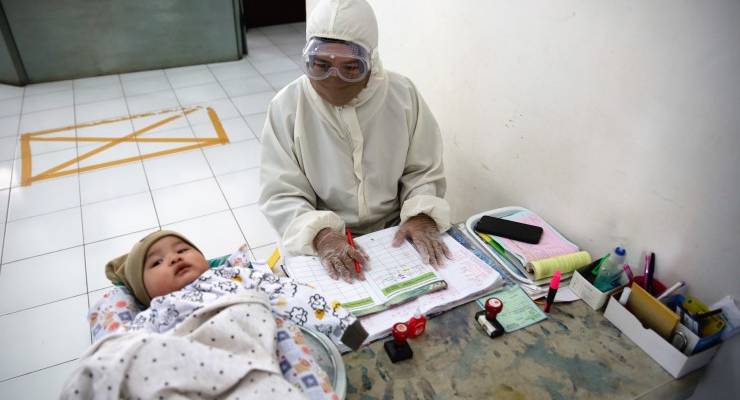
This is part one in a two-part series on Australia’s international humanitarian response to the pandemic.
When COVID-19 struck, Australia quickly restructured its foreign aid budget, redirecting $280 million to assist its Indo-Pacific neighbours — some of whom were the least pandemic-prepared in the world.
But the money has come from already cash-strapped programs. No new cash has been pledged.
Australia’s dwindling foreign aid has been a contentious issue for some time. Health initiatives funded by Australia risk being undone, and in the face of the pandemic the ramifications are deadlier than ever.
Australia’s foreign aid is in freefall — the fallout could be massive.
Where’s the aid going?
The Pacific has long been a major focus for Australia’s aid strategy. The Coalition’s Pacific Step-up program saw this focus narrow towards Pacific Islands, with Prime Minister Scott Morrison donning a themed shirt and hopping around climate change-affected areas.
Australian aid to the Pacific region over the past 10 years exceeded the combined aid of the next four largest donors — New Zealand, China, Japan and the United States. Papua New Guinea has received the bulk of support, receiving $512 million by the latest budget estimate.
But when the pandemic struck, the Department of Foreign Affairs and Trade (DFAT) realised that focusing aid in one area — and mostly in one country — wasn’t such a good idea, and developed the Partnerships for Recovery program, a two-year aid plan which adds Timor-Leste and Indonesia to its list of high-priority countries.
The $280 million in restructured funds came from initiatives like the Australian Volunteers Program, scholarships programs, and sports for development programs (but the volunteer program would continue in partial capacity, a DFAT spokesperson confirmed).
Global Health Alliance Australia executive director Misha Coleman told Inq the cost of the pandemic was dwarfing Australia’s aid response.
“The biggest danger right now is that new money being allocated to COVID-19 responses could cannibalise other programs or whole country commitments if the total aid budget is not increased,” she said.
Australia has deployed health experts to a World Health Organization regional office and the Solomon Islands Ministry of Health. More than 2.6 million pieces of protective equipment (PPE) have been provided to 23 countries and territories, and more than $100 million (more than a third from the redirected pandemic response) has been given to Pacific countries to meet basic running costs.
The government pledged $300 million to improve access to vaccines in the Indo-Pacific. It also helped Pacific partners organise laboratories, medical equipment, health expertise and public information campaigns, helping ensure the continued supply of essential medical and testing equipment, critical personnel, and food and essential supplies.
A spokesperson for DFAT told Inq future funds will be determined through the budget process. “We expect allocations will reflect the priorities outlined in the Partnerships for Recovery policy.”
A drop in the bucket
Foreign aid has been in freefall since 2013 and currently sits at its lowest ever level — just 0.21% of our gross national income. It will keep trending backwards towards $4 billion in 2020–21 — a figure likely to get smaller as Australia faces its biggest-ever budget deficit.
Since 2014, aid to Africa and the Middle East has been slashed by $188.4 million, or 48.5%. Aid was cut to South-East Asian countries by 42%.
Indonesia, recently deemed a priority for Australia’s aid, lost nearly half its funding — 85% of those cuts came from healthcare. There, a COVID-19 test in a hospital costs three times the monthly minimum wage. Australia and Indonesia’s trade partnership was worth $16.8 billion in 2017–18.
Even the Pacific Islands, the focus of so much of Australia’s aid, has seen numbers slashed. Vanuatu and the Cook Islands have lost 42.1% and 26% of their aid respectively.
This means that when the pandemic struck, many countries around the world were far worse off than they were in previous years.
Australian Council for International Development (ACFID) chief executive officer Marc Purcell told Inq the funding had been overshadowed by the pandemic, and that a recently-announced parliamentary inquiry into the implications of the COVID-19 pandemic for Australia’s foreign affairs, defence and trade will reflect this.
“We think the evidence will show that there is a disjuncture between the Australia government’s assessment of this crisis and the level of resources it is committing to it,” he said.
ACFID has called for an extra $2 billion to be injected into overseas development aid across four years. Instead, the Morrison government has announced a $270 billion plan to increase Australia’s defence capabilities.
What are the health ramifications?
Last week a study in The Lancet found disruptions from COVID-19 could see malaria deaths increase by 36% over the next five years. Tuberculosis deaths could increase by 20%, and HIV deaths by 10% compared to a non-pandemic period.
“Projections are that we’re likely to lose the gains we’ve made in those three diseases in the Asia-Pacific region,” Coleman said.
“To lose those gains would be a shocking consequence of diverting the aid dollar away from those priorities.”
Since 2017, Australia has committed more than $110 million to address malaria, tuberculosis and HIV through the government’s Indo-Pacific Centre for Health Security.
“Australia is pivoting its development program to ensure critical health services in our region continue to function amidst COVID-19,” a DFAT spokesperson said.
Globally, the World Health Organization has reported an alarming decline in the number of children receiving vaccines. Of countries surveyed, 85% said the level of vaccination was lower in May than in January-February of this year thanks to COVID-19 disruptions and limited PPE.
In Indonesia, HIV testing has dropped by half compared to the same time in 2019, as have the number of patients receiving HIV antiretroviral treatment. Papua, which has one of the highest rates of malaria in Indonesia, has limited malaria testing and a bed net campaign postponed by four months. Dengue fever cases surged across Fiji and the Marshall Islands.
“Diseases like COVID-19 show us that borders don’t mean much anymore,” Coleman said. “Multidrug-resistant strains of tuberculosis are of major concern in neighbouring countries.”
Pacific Friends of Global Health chair Professor Brendan Crabb echoed these sentiments.
“Major global crises — whether they be financial, conflict or infectious diseases — lead to human devastation way beyond that caused by the malady itself,” he said. “When already fragile health services in lower-middle income countries are challenged in this way, they often collapse. In these circumstances, causes of poverty-related poor health such as those caused by HIV, TB, malaria, rebound rapidly.”
Purcell added: “These kinds of health impacts could cripple the region’s economic recovery and undermine political and social cohesion as inequities in access to life-saving health services are further exposed. This would clearly undermine Australia’s interests in a stable, prosperous and resilient region.”
There’s a massive hole in Australia’s humanitarian response. China has seen that hole — and has started to fill it.
Next: China fills Australia’s vacuum in the Pacific








Our foreign aid program has been in freefall since 2012 and the reason has little to do with the COVID19 pandemic of 2017.
The pandemic creates issues of affordability for the donor.
The freefall was caused by declining demand. Pacific nations declined Australian aid once they understood the new, selfish Australian motives typefied by the bugging of Timor under the guise of foreign aid.
When Timor expressed criticism at the International Court of Justice, Alexander Downer’s response was “Timor has made a bad choice of actions. After all we have done for them!” Downer’s remark was read by the Pacific as meaning “recipients of Australian Aid should allow themselves to be screwed”.
Australian diplomats and trade commissioners spent decades of their careers building our influence especially in the Pacific. Our reputation was trashed by the Howard government’s actions and nobody wants our Trojan Horses. This is going to take a lot of fixing.
As I said, the pandemic creates issues of affordability for the donor. Those issues would have been resolved if the Howard government had not given away all of the gas from Greater Sunrise to Woodside and partners. That gift, at the expense of the taxpayers of Australia, was used to curry political donations. It could have funded our Foreign Aid program.
We can’t keep bribing climate victims into silence. Sooner or later, we will have to actually do something about it.
I support the view that Australia should be more generous with its foreign aid, but there is one significant qualification. The aid should achieve something useful, and ideally actually be effective in achieving outcomes. Internationally there is a strong view among aid professionals that most projects fail to achieve the often grand objectives set out for them. However many (not quantifiable, but argued to be a majority) do achieve some useful outcomes, even if they are not necessarily those planned.
The giant problem that is not addressed in Australia’s aid programme is Papua-New Guinea. Vast amounts of Australia’s aid (and the PNG governments own funds) disappear into corrupt activities within various levels of government. Sometimes useful outcomes are still achieved. However the direct budget support to the PNG government is like pouring money down a bottomless pit.
It is not stupidity that continues this funding, but the need to maintain influence in PNG. However to compete with China Australia will have to be prepared to throw more money down the hole than the Chinese are spending on PNG. Any rethink of Australian aid needs to get around the corruption problem (the official euphemism is probably misapplication, or if we are being tough misallocation). We don’t say nasty words like corruption to our allies.
If the money spent was used effectively it could make a considerable difference. There are mechanisms for this, such as working with NGOs, community groups and charities. But governments pretty much everywhere get very antsy about aid that does not flow through them.
The lack of generosity, or even strategic international relations, is hardly new to the LNP. Labor wasn’t that much better, but they are hemmed in by their opposition and the right leaning MSM.
They know the price of everything, and the value of nothing.
One of the best-for-money foreign aid has been the overseas service of the ABC. Its trusted standard of journalism provides soft intelligence about each of our neighbours, for our neighbours. An agent for peace and harmony. Once broadcast as Radio Australia, it reemerged online. Its travel budgets are always strapped for cash, limiting its capacity to deliver the stories that matter.